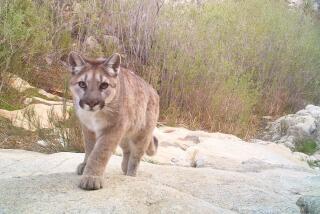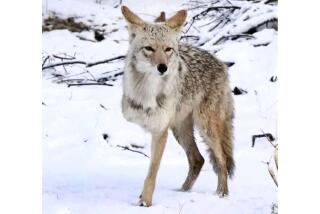Gray wolf travels more than 500 miles, then gets shot in Utah
Long trip, sad ending.
A 3-year-old female gray wolf, after traveling more than 500 miles from Wyoming, was shot and killed in southwestern Utah after a hunter apparently mistook her for a coyote, state officials said Monday.
The wolf had been radio-collared in January near Cody, Wyo., and was shot on Sunday near the south end of the Tushar Mountains, near Beaver, Utah, according to the Utah Division of Wildlife Resources. The hunter notified officials after noticing the wolf’s tracking collar, officials said.
The wolf could be the same one from the northern Rocky Mountains spotted just north of the Grand Canyon National Park in November, said one area wildlife activist, Kirk Robinson, executive director of the Western Wildlife Conservancy, a nonprofit in Utah.
“There were at least two wolves in the region that had radio collars,” Robinson told the Los Angeles Times. “This could be either of them, or it could be a third one.”
Gray wolves are endangered in much of the U.S. and are not generally known to inhabit most of Utah. Killing endangered animals can incur fines or prison time under the Endangered Species Act.
The federal Fish and Wildlife Service said it was working with Utah on the investigation and would compare the dead wolf’s DNA with DNA previously gathered from the Grand Canyon wolf to see if it’s the same animal.
The Salt Lake Tribune reported that this was the first reported death of a gray wolf in Utah since gray wolves were reintroduced into Yellowstone National Park and Idaho in the 1990s.
Robinson raised doubts that the gray wolf could easily be mistaken for a coyote.
“Wolves are quite a bit bigger than coyotes,” Robinson told the Los Angeles Times. “Even a small wolf like this is twice as big as your average coyote.”
Robinson added that a Utah state program that pays out $50 bounties to hunters for killing coyotes -- in order to keep down the predator population -- may create greater risks for other animals, like wolves, that could potentially be mistaken for coyotes.
Follow @MattDPearce for national news
More to Read
Start your day right
Sign up for Essential California for news, features and recommendations from the L.A. Times and beyond in your inbox six days a week.
You may occasionally receive promotional content from the Los Angeles Times.







